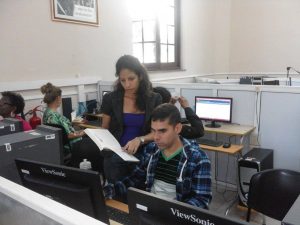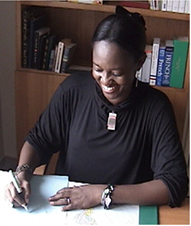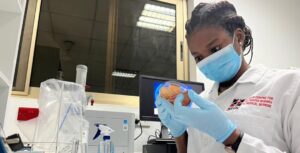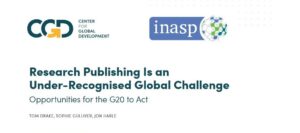
Creating a successful MOOC for academics in low-resource settings
Since 2013, AuthorAID’s online courses in research writing have provided support to thousands of early-career researchers in the Global South. In a post based on a recent eMerge webinar, Andy Nobes reflects on some of the lessons learnt.
Over the last four years, enrolment on INASP’s AuthorAID online course in research writing has increased 800%. Back in 2013, our largest course had 50 learners. In 2015, we ran our first Massive Open Online Course (MOOC) for more than 1,000 learners. This summer, our MOOCs reached over 4,000 learners from 100+ developing countries. The courses are designed to support early-career researchers in lower and middle-income countries to publish and communicate their work, and the attendance demonstrates that there is a clear demand for this kind of skills development.
But can a MOOC of this size truly build researchers’ capacity and achieve impact in the long term? And if so, what techniques have we learned whilst running our MOOC for academics in low-income settings that others can use and adapt?
MOOCs can have long-term impact
Researchers in low and middle-income countries face multiple challenges in publishing their work in peer-reviewed journals. These challenges include knowing how to structure a research paper, finding the right journal, and navigating the publishing and peer-review process.
The AuthorAID MOOCs aim to help early-career researchers solve some of these challenges and our recent impact study shows that these courses are working. Half of the 7,454 participants in our last four MOOCs completed the course, well above the average completion rate for a MOOC (which is typically 3-15%). Furthermore, 36% of participants published a paper one year after taking the course, and most people who completed a MOOC reported an increase in confidence, a better understanding of the publishing process and more confidence in the quality of their writing.
Ravi Murugesan speaking about AuthorAID MOOCs in 2016
These impacts are a result of constantly developing and assessing the MOOCs we have run over the last four years. Here we share our lessons on what we think makes an engaging and successful MOOC for developing-country adult learners, so that others can learn and build upon this and move online learning in Africa and Asia forward.
Lessons for a successful MOOC
We’ve adapted our pedagogical approach according to teaching techniques in Randy Garrison’s ‘Community of Inquiry Model’ (see, our recent paper), which focuses on three ’presences’:
Friendly, open and responsive ‘teacher presence’
We made sure the teachers and facilitators were present and approachable throughout the course using:
- Short, simple introductory videos that helped participants get to know the personality of teachers and facilitators
- Friendly weekly updates with upcoming course content, average quiz scores and general encouragement and tips
- A team of ‘guest’ facilitators on hand to answer questions in the forums
- An informal engagement style that shows teachers are friendly and approachable.
- Recorded video discussions using Google Hangouts
“I think [the video discussion] was useful because it addressed and summarized the top questions that have been discussed in the forums these weeks. But mostly because it was nice to put faces and voices to some of the facilitators which gave me a sense of nearness” – MOOC participant
The guest facilitators p lay a critical role in the success of our MOOCs. Our guest facilitators are a geographically diverse mix of experienced AuthorAID mentors and associates, and highly engaged participants from previous MOOCs. The facilitator’s main role is to respond to the participants’ questions on the course forums and moderate discussions on hot topics such as research and publication ethics. Our feedback surveys have revealed that most participants get useful responses when they pose questions in our forums. This engaged teacher presence differentiates our course and contributes to the high completion rate.
lay a critical role in the success of our MOOCs. Our guest facilitators are a geographically diverse mix of experienced AuthorAID mentors and associates, and highly engaged participants from previous MOOCs. The facilitator’s main role is to respond to the participants’ questions on the course forums and moderate discussions on hot topics such as research and publication ethics. Our feedback surveys have revealed that most participants get useful responses when they pose questions in our forums. This engaged teacher presence differentiates our course and contributes to the high completion rate.
Deeper learning of participants though ‘cognitive presence’
Keeping students engaged in course content can be tricky. We used the following techniques to keep students interested:
- Triggering deep learning through controversial topics. We made the mos
 t of controversial topics on the course, such as research ethics, plagiarism, authorship, and ‘predatory’ journals. Content on these hot topics encouraged discussion and helped participants stay engaged.
t of controversial topics on the course, such as research ethics, plagiarism, authorship, and ‘predatory’ journals. Content on these hot topics encouraged discussion and helped participants stay engaged. - Encouraging self-reflection through peer assessment. We included peer assessment exercises to encourage self-reflection and help put the learner in the shoes of the assessor. Feedback from participants shows how it helped them get perspectives from different cultures and to think deeper about how they approach the tasks and the course subjects.
“…being in a group of people, even though you don’t see each other, you can ask them a question if you don’t understand somewhere, and they replied back…we were given some task of writing … and then we marked each other’s papers and came up with recommendations – that was a great experience I had.” – Course participant Tanzania
Connected learning with ‘social presence’
In previous online courses, our feedback surveys showed most participants preferred connected to separate learning. We therefore made sure our MOOC had plenty of opportunities to create a community of learners by:
- Guest facilitators and peers engaging discussion. Guest facilitators encouraged and engaged discussion in the forums. The diversity of experience between facilitators often meant that questions received more than one answer, and also encouraged responses from their peers on the course.
- Focussed discussion through well-structured forums. Rather than creating one big forum we opened a new sub-forum for each week (often gradually introduced) so participants could have more focussed discussions on the weekly topics.
- Encouraging participants to introduce themselves, to share their location on a ‘pinboard map’ of the world, and also via a ‘research collaboration’ forum.
- Building social presence and affinity via a photo competition that challenged participants to capture and share a picture of them carrying out their research.
We found that the forum interaction on our MOOCs was very high compared to activity in other MOOCs and that this unique aspect of our course helped us achieve our high completion rate – 80% of the participants who wrote at least one post went on to complete the course; compared to only 36% of participants who made zero posts in the forums. Creating a supportive teacher and peer-learning culture is vital to the success of our MOOCs.
Lessons for long-term impact
We have found MOOCs in low and middle-income countries can be successful and have long-term impact if:
- Course content is tailored to the audience – both in terms of course material and technical limitations (e.g. internet bandwidth)
- The course uses engaging teaching techniques, and doesn’t rely on video lectures
- The course has dedicated facilitators (even as volunteers)
- The course meets the needs of a specific audience
We have run five MOOCs in the past two years with a small core team, a network of enthusiastic volunteers, and open-source technologies. We’ve seen encouraging completion rates and evidence of real-world impact. If we can do it, so can you!
For more on these lessons learnt, see our new Learning, Reflections and Innovation paper here.

 Next Post
Next Post


